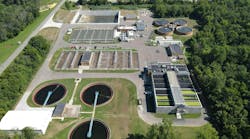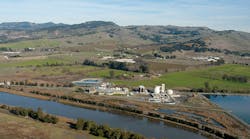For the past two decades, Forsyth County, Ga., has grown at a staggering rate—its population has more than quadrupled since 1990. It is located just northeast of Atlanta, and its proximity to that bustling city has made it an increasingly popular place for commuters to live. The residents of Forsyth County also tend to be quite affluent. According to the 2014 American Community Study conducted by the U.S. Census Bureau (the most recent available information), its median household income is estimated to be $85,639, far greater than the national figure of $53,657.
Much of the county’s wastewater treatment is managed by individual septic systems, publicly owned facilities and contracted capacity in the city of Cumming, the county’s seat and largest city. Since 1993, the county’s master planning documents have recommended the construction of a new, state-of-the-art wastewater treatment facility near the Chattahoochee River. In 1996, the county acquired a suitable site for the project—the 315-acre Shakerag property, located on the river in the southeastern portion of the county in the city of Suwanee.
The county hired CH2M to design the facility, and after a lengthy permitting process—which included obtaining a National Pollutant Discharge Elimination System permit from the U.S. Environmental Protection Agency to allow discharge into the river—it contracted with PC Construction to build the plant. Work began on the Shakerag Water Reclamation Facility (WRF) in February 2014. The total projected cost of the project is approximately $31 million.
Nuts & Bolts
The Forsyth County Department of Water and Sewer worked closely with CH2M to create the facility, and the result was a thoughtful pretreatment process.
“The plant was designed with input from county operators, beginning with the concept stage,” said Barry H. Lucas, P.E., deputy director of the Forsyth County Department of Water and Sewer. “One of the components that resulted from this collaboration between operations staff and design engineers is a 4-million-gal equalization tank and transfer pump station. In addition to providing emergency storage, the equalization tank will allow the plant to be operated at a constant pace throughout all inflow scenarios by routing screened and de-gritted inflow to the tank for storage prior to routing to the process trains.”
The facility will employ a membrane bioreactor treatment process consisting of bioreactors with a combination of anaerobic, anoxic and aerobic zones, allowing the facility to meet permit nutrient limits without the use of chemicals. The effluent produced by the plant will be discharged via a pipe system in the Chattahoochee River, which will include a flow control vault, a cascade aerator and an HDPE diffuser installed under the riverbed.
From Out of Nowhere
Building a state-of-the-art water reclamation facility on previously undeveloped land has been one of the most significant challenges that PC and Forsyth County have faced during the construction of the Shakerag plant. At the outset of the project, PC worked with Georgia Power to install temporary utility poles that carry electricity to the site during construction and establish the foundation of a permanent power solution. In addition, a septic system was created to deal with waste at the construction site. This system will subsequently serve the plant’s administration building, allowing it to be occupied during the facility’s startup phase. PC also established permanent Internet service to the field offices at the site; this will be transferred to the plant when it begins operation.
The installation of the diffuser—also conducted by PC—was complicated by other public works projects on the Chattahoochee.
“One of the construction challenges was the rise and fall of the water level in the Chattahoochee River due to operations at Buford Dam,” said Lucas. “The Shakerag site is located approximately 8.5 miles below Buford Dam [on Lake Lanier], which is owned and operated by the U.S. Army Corps of Engineers. The river rises approximately 8 to 10 ft when water is being released for power generation from Buford Dam, which is typically on a daily basis, excluding weekends. The contractor, operating from barges in the river, was only able to perform construction during minimum release, low water conditions.”
During construction, the barges used turbidity curtains and other measures to lessen the environmental impact on the river.
The Shakerag WRF is expected to go online in spring 2016. It will initially offer a treatment capacity of 1.25 mgd and will be set up for an easy phase-two expansion to 2.5 mgd.
Download: Here


